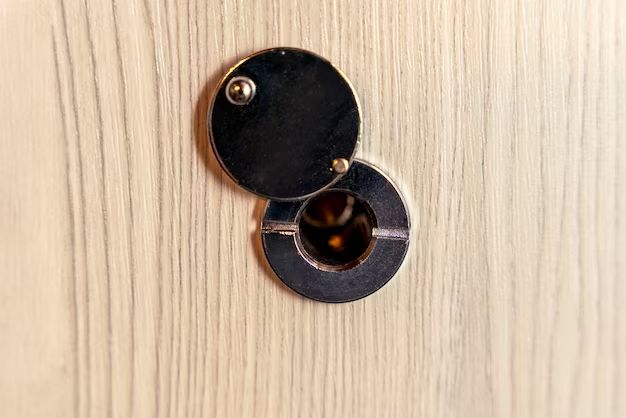Peepholes have been a ubiquitous feature of front doors for generations, allowing residents to visually identify visitors before deciding whether or not to open the door. The basic peephole design consists of a small lens set into the door at eye level, providing a fish-eye view of the outside. While technology has radically transformed many aspects of modern homes, the familiar peephole remains largely unchanged. So do most front doors today still have peepholes? Let’s take a closer look.
Page Contents
Brief history of peepholes
The origins of peepholes can be traced back as far as the Middle Ages. Primitive peepholes consisted of small openings bored directly through the door. These allowed occupants to peer out from the inside. The fish-eye peephole lens was invented in the 1830s by Dr. Robert Hooke. His optical design used a ball lens to provide a wide viewing angle. This allowed a much better view of the outside compared to a simple hole. Peepholes saw growing popularity in urban areas during the Victorian era. They provided security and privacy as front doors transitioned from solid wood to include glass panels. By the early 1900s peepholes were a common component of exterior doors.
Prevalence of peepholes today
Peepholes continue to feature on a majority of exterior doors in modern homes. A 2016 survey showed that 89% of front doors have peepholes installed. They remain highly popular for several reasons:
Security
Being able to visually verify visitors from the safety of inside remains a priority for many homeowners. Rising crime rates in some areas have also prompted increased security precautions.
Privacy
Peepholes allow homeowners to maintain privacy. They can observe who is outside without opening the door. This prevents unwanted visitors from being able to look inside.
Convenience
Quickly checking who is at the door is more convenient than alternatives like windows or video cameras. Peepholes provide instant visual access without having to go to another part of the house.
Familiarity
After generations of use, peepholes are simply what people expect front doors to have. Their continued presence provides a sense of tradition.
Inexpensive option
Simple peephole lenses can be purchased very cheaply. Installation is also straightforward for DIY homeowners. This makes them a budget-friendly security option compared to high-tech digital systems.
Modern front door trends
While peepholes maintain their place on most doors, some modern design trends have shifted preferences in certain situations:
Smart home systems
Home automation technology like video doorbells and smart locks are growing in popularity. These integrate camera and app connectivity, providing enhanced security features over old peepholes. However, higher costs prohibit many homeowners from adopting them.
Natural light
Interior design trends emphasize bringing natural light indoors. Front doors with full glass panels or sidelights allow sunlight inside while improving visibility. This reduces the need for peepholes in some modern and contemporary homes.
Farmhouse style
Classic farmhouse doors with full wood construction remain on-trend. Their solid build provides security, so peepholes are not always incorporated in this rustic style.
Minimalist style
The pared-back, clean lines of modern minimalist door designs sometimes exclude additional elements like peepholes. Security takes a backseat to aesthetics for these statement doors.
However, while these looks grow in popularity, most mainstream suburban homes still opt for conventional doors with peepholes.
Reasons peepholes are excluded on some doors
There are some situations where peepholes are omitted by choice or necessity:
Fire doors
Building code requires fire rated doors in stairwells and corridors of multi-family properties. The integrity of these solid core doors cannot be compromised by drilling viewing holes.
double doors
The additional width and geography of double entry doors makes peepholes impractical. Side window panels are often used instead for visibility.
Cost savings
On inexpensive hollow core doors without glass, builders sometimes leave out peepholes to save on costs.
Rarely used doors
Homeowners may decide peepholes are unnecessary on rarely used side or back doors leading to a porch or garage.
Elderly safety
For aging homeowners, peeping through a hole can require balance and coordination. Difficulty peering out may lead to removing peepholes.
Are peepholes going away?
Despite some shifts in features on modern front doors, peepholes remain the norm across most residential homes. Recent data indicates:
89% of front doors have peepholes
A clear majority of homes still have them installed. This number has only dropped slightly over the past decade.
61% would not remove peephole
In a survey, most homeowners reported they would not consider removing or disabling their existing peephole.
55% of buyers look for peepholes
Over half of prospective home buyers still actively check for presence of a peephole during showings. This suggests most expect them to be included.
67% use peephole weekly
Two-thirds of homeowners indicate actively using their peepholes at least once a week. This shows continued utilization despite technology alternatives.
Conclusion
While smart home gadgets introduce new ways to see who is at the door, good old peepholes remain the status quo. The vast majority of front doors in homes today continue to feature simple viewing lenses. With their low cost, security, convenience, and familiarity, peepholes seem poised to persist in their role for the foreseeable future. As long as front doors have existed, there has been a need to see outside before opening up. Simple peephole lenses satisfy this need in a timeless, low-tech manner. They are a fixture generations have relied upon when making the decision of whether or not to answer the door.
